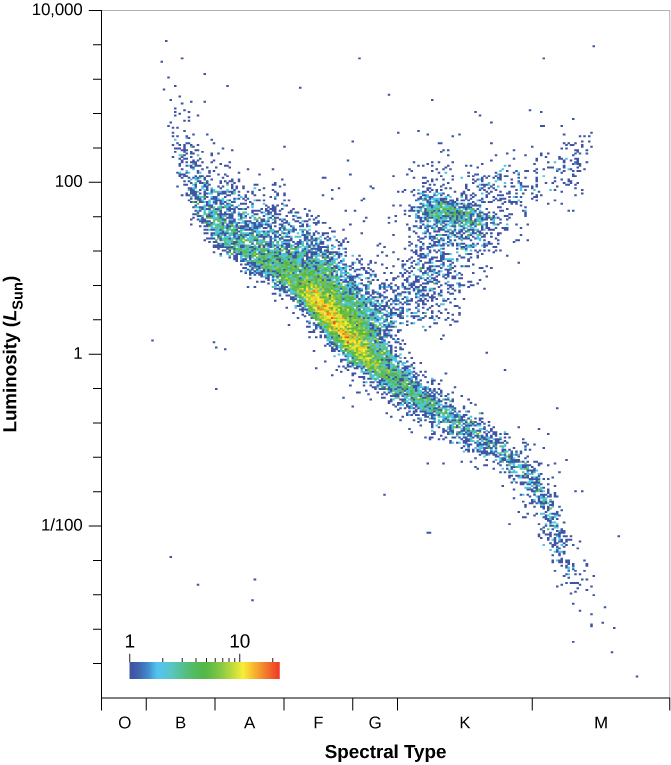| << Chapter < Page | Chapter >> Page > |
The measurements of stellar parallax were revolutionized by the launch of the spacecraft Hipparcos in 1989, which measured distances for thousands of stars out to about 300 light-years with an accuracy of 10 to 20% (see [link] and the feature on Parallax and Space Astronomy ). However, even 300 light-years are less than 1% the size of our Galaxy’s main disk.
In December 2013, the successor to Hipparcos, named Gaia , was launched by the European Space Agency. Gaia is expected to measure the position and distances to almost one billion stars with an accuracy of a few ten-millionths of an arcsecond. Gaia’s distance limit will extend well beyond Hipparcos, studying stars out to 30,000 light-years (100 times farther than Hipparcos, covering nearly 1/3 of the galactic disk). Gaia will also be able to measure proper motions Proper motion (as discussed in Analyzing Starlight , is the motion of a star across the sky (perpendicular to our line of sight.) for thousands of stars in the halo of the Milky Way—something that can only be done for the brightest stars right now. At the end of Gaia’s mission, we will not only have a three-dimensional map of a large fraction of our own Milky Way Galaxy , but we will also have a strong link in the chain of cosmic distances that we are discussing in this chapter. Yet, to extend this chain beyond Gaia’s reach and explore distances to nearby galaxies, we need some completely new techniques.

One of the most difficult things about precisely measuring the tiny angles of parallax shifts from Earth is that you have to observe the stars through our planet’s atmosphere. As we saw in Astronomical Instruments , the effect of the atmosphere is to spread out the points of starlight into fuzzy disks, making exact measurements of their positions more difficult. Astronomers had long dreamed of being able to measure parallaxes from space, and two orbiting observatories have now turned this dream into reality.
The name of the Hipparcos satellite, launched in 1989 by the European Space Agency, is both an abbreviation for High Precision Parallax Collecting Satellite and a tribute to Hipparchus, the pioneering Greek astronomer whose work we discussed in the Observing the Sky: The Birth of Astronomy . The satellite was designed to make the most accurate parallax measurements in history, from 36,000 kilometers above Earth. However, its onboard rocket motor failed to fire, which meant it did not get the needed boost to reach the desired altitude. Hipparcos ended up spending its 4-year life in an elliptical orbit that varied from 500 to 36,000 kilometers high. In this orbit, the satellite plunged into Earth’s radiation belts every 5 hours or so, which finally took its toll on the solar panels that provided energy to power the instruments.
Nevertheless, the mission was successful, resulting in two catalogs. One gives positions of 120,000 stars to an accuracy of one-thousandth of an arcsecond—about the diameter of a golf ball in New York as viewed from Europe. The second catalog contains information for more than a million stars, whose positions have been measured to thirty-thousandths of an arcsecond. We now have accurate parallax measurements of stars out to distances of about 300 light-years. (With ground-based telescopes, accurate measurements were feasible out to only about 60 light-years.)
In order to build on the success of Hipparcos, in 2013, the European Space Agency launched a new satellite called Gaia . The Gaia mission is scheduled to last for 5 years. Because Gaia carries larger telescopes than Hipparcos, it can observe fainter stars and measure their positions 200 times more accurately. The main goal of the Gaia mission is to make an accurate three-dimensional map of that portion of the Galaxy within about 30,000 light-years by observing 1 billion stars 70 times each, measuring their positions and hence their parallaxes as well as their brightnesses.
For a long time, the measurement of parallaxes and accurate stellar positions was a backwater of astronomical research—mainly because the accuracy of measurements did not improve much for about 100 years. However, the ability to make measurements from space has revolutionized this field of astronomy and will continue to provide a critical link in our chain of cosmic distances.
The European Space Agency (ESA) maintains a Gaia mission website where you can learn more about the Gaia mission and to get the latest news on Gaia observations.
To learn more about Hipparcos, explore this European Space Agency webpage with an ESA vodcast Charting the Galaxy—from Hipparcos to Gaia .
For stars that are relatively nearby, we can “triangulate” the distances from a baseline created by Earth’s annual motion around the Sun. Half the shift in a nearby star’s position relative to very distant background stars, as viewed from opposite sides of Earth’s orbit, is called the parallax of that star and is a measure of its distance. The units used to measure stellar distance are the light-year, the distance light travels in 1 year, and the parsec (pc), the distance of a star with a parallax of 1 arcsecond (1 parsec = 3.26 light-years). The closest star, a red dwarf, is over 1 parsec away. The first successful measurements of stellar parallaxes were reported in 1838. Parallax measurements are a fundamental link in the chain of cosmic distances. The Hipparcos satellite has allowed us to measure accurate parallaxes for stars out to about 300 light-years, and the Gaia mission will result in parallaxes out to 30,000 light-years.

Notification Switch
Would you like to follow the 'Astronomy' conversation and receive update notifications?